NELL LUKOSAVICH, Senior Editor
With the advancement in design standards, maintenance, testing and safety since the Macondo oil spill two years ago, a special emphasis is being placed at OTC 2012 on operational integrity and its fundamental role in offshore operations and regulatory changes. OTC 2012 will feature over 300 technical presentations, panel sessions, discussion forums and special events relating to current challenges and the future direction of the offshore oil and gas industry.
OTC 2012 will be held Apr. 30–May 3, at the Reliant Park complex in Houston, Texas. Attendance totaled 78,645 people from 110 different countries at last year’s show—the second highest level of attendance since 1982, when 108,161 visitors attended OTC. More than 2,500 exhibiting companies from 41 countries filled the exhibition area’s 603,150 sq ft, which also neared the 1982 record of 631,000 sq ft of exhibit space. In 2012, the show will break the 1982 record, with 635,000 sq ft of exhibition space expected to be used.
This year’s show will be chaired by Joseph Reilly, ExxonMobil Upstream Research’s senior geophysics technical consultant. In addition to being the Program Chairman for OTC, he is on the Board of Directors of the International Petroleum Technology Conference (IPTC), an SEG/SPE/AAPG/EAGE corporation. In 2011, he was elected to Life Membership in the SEG.
What’s new this year. OTC TV is a new initiative launched to capture the news of the day during the show. Content will consist of interviews with the OTC Board of Directors and key speakers; special events; and activity on the exhibition floor. OTC TV can be seen on the video walls in Reliant Center and Reliant Arena, on large broadcasting trucks out in the Parkway, and on OTCnet.org/2012. It will also feature advertorials from exhibitors about their offerings.
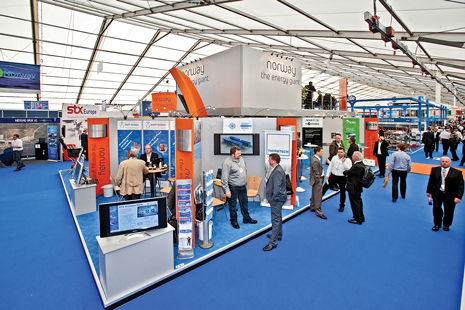 |
| OTC 2011 exhibition hall. Photo: Barchfeld Photography. |
|
Seven topical breakfasts and luncheons are new to this year’s show. Topics include “The Center for Offshore Safety,” “The new Bureau of Safety and Environmental Enforcement: What to expect,” “British innovation in the global oil & gas supply chain,” “Energy policy in the United States: Realities, fantasies and rhetoric,” “Prudent development of North American natural gas and oil resources study,” “The UH Energy Research Park: An investment in Houston’s future” and “Israeli government’s role as a facilitator: Near- and long-term success in the emerging energy sector.”
Due to popular demand, the OTC Parkway outdoor exhibition space has been expanded, to add a new air-conditioned pavilion. This pavilion will be in the parkway between the Reliant Center and Reliant Arena, which adds an additional 26,000 sq ft of exhibit space.
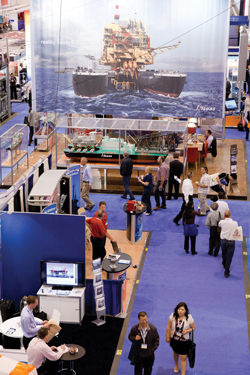 |
| OTC 2011. Photo: Barchfeld Photography. |
|
Annual OTC dinner. The 2012 conference will host the second Annual OTC Dinner, which will be held at the George R. Brown Convention Center on Sunday, April 29, from 6:00 to 10:30 p.m. The dinner will recognize the OTC Distinguished Achievement Award recipients and provides an opportunity for industry professionals to network with colleagues from around the world.
The dinner raises funds to benefit Engineers Without Borders (EWB) USA, a nonprofit humanitarian organization established to support community-driven development programs worldwide through partnerships that design and implement sustainable engineering projects.
EWB members, comprised of professional and student engineers or other disciplines, work with local communities and NGOs in over 45 developing countries around the world on projects, such as water, renewable energy, sanitation and more. Members and partners support its core values of integrity, service, collaboration, ingenuity, leadership and safety.
Awards presentation. Joe Burkhardt, a subsea drilling and production engineer with ExxonMobil’s Production Research Division, will receive the 2012 OTC Distinguished Achievement Award for Individuals during the OTC Dinner on Sunday, April 29.
Burkhardt will be given the award in recognition of his long, distinguished record of excellence in developing subsea and offshore technology advancements and tools, including development of many unique concepts still in use today. His work includes developing software to predict pressure surges while tripping drillpipe or running casing, and designing, building and testing a prototype Submerged Production System (SPS).
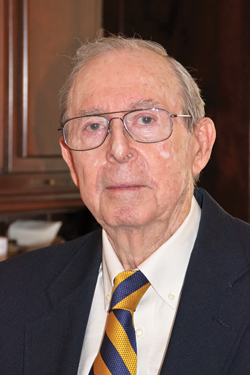 |
| Joe Burkhardt, OTC Distinguished Achievement Award recipient. |
|
Also at the dinner, Shell will receive the Distinguished Achievement Award for Companies, Organizations and Institutions. The company is being recognized for its development of three fields at Perdido, featuring the deepest water depth (7,999 ft) for a oil and gas drilling and production platform in the world. This world-class project in the Gulf of Mexico pioneered several technological firsts in ultra-deepwater development and production, and has achieved an exemplary safety record.
Next Wave program. The Next Wave program, designed for upstream professionals under age 35 and companies interested in recruiting them, will take place on Monday, April 30, from 8:15 a.m. to 2:30 p.m. The 2012 event will focus on the challenges and responsibilities that young adults will face throughout the next several decades of their careers. Lee Tillman, vice president of engineering for ExxonMobil Development Company, will deliver this year’s keynote address. Speakers from World Energy, KBR, Noble Energy, ConocoPhillips, NOV and Schlumberger will participate in a morning panel discussion. A reception will be held following the program, from 5:00 to 6:30 p.m. in Reliant Center.
NEED Energy Education Institute. As in past years, the U.S. National Energy Education Development (NEED) project, a provider of energy education materials to U.S. schools, will host a one-day event called the Energy Education Institute on Thursday, May 3, at Reliant Center for Houston-area educators and high school students. The teacher workshop will provide educators with innovative ways to energize their energy curriculum and new information about advances in exploration and production of oil and natural gas. The student event aims to educate the next generation of aspiring engineers, scientists and managers about the oil and gas industry through a series of discussion forums, a scavenger hunt of the technology exhibits and hands-on energy lessons. Additionally, students will be able to meet industry professionals and ask questions about possible careers in the oil and gas industry.
Featured presentation topics. This year’s show will feature a series of presentations by major IOCs, NOCs and independent operators, including Total, ExxonMobil, Shell, CNOOC and ADNOC, who will present their views on future industry directions, operational integrity and risk management.
Several panel discussions will focus on the aftermath of the Macondo oil spill and its impact on the industry two years later. There will be a technical session on the topic, “Enhancing industry spill response capabilities,” and two panel discussions on “Risk management strategies for deepwater exploration and development” and “Improving operational integrity in offshore energy operations: a global perspective.”
A series of presentations will be made on the management of major projects. Projects to be discussed include Jubilee (Tullow), Marlim (Petrobras), Who Dat (LLOG), Pazflor (Total) and Nikaitchuq (Eni). Additionally, Y.L. Darricarrère, CEO of Total E&P, will discuss the achievements and prospects in West Africa.
Technical program. More than 300 papers will be presented during the show’s technical sessions, (Table 2).
| Table 2. 2012 technical programs |
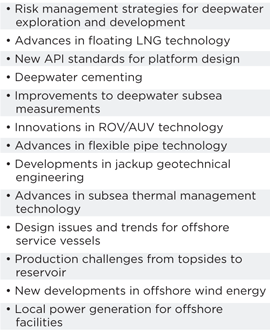 |
Several topics this year, which have been regularly presented at OTC in the past, will again highlight continuing advancements in technologies that continue to improve and broaden their scope of applicability. These topics include deepwater moorings, drilling and well completions, flow assurance, process safety, geotechnics and soil mechanics, pipelines, metocean, ocean mining, flexible pipe, and inspection and maintenance.
New topics introduced at this year’s show include new standards for jackups and platforms, global LNG, innovative FPSO and offshore offloading solutions, drilling over 15,000 psi and deepwater cementing.
The major technical session topics are listed in Table 1. For a more detailed listing of individual papers in the technical program, please check the listings at http://www.otcnet.org/2012/pages/schedule/tech_program/index.php 
| Table 1. OTC 2012 technical sessions |
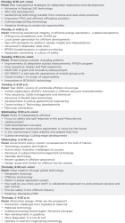 |
|
SPOTLIGHT ON NEW TECHNOLOGY AWARDS
Now in its ninth year, this program will recognize 13 technologies representing 12 companies: Baker Hughes, ClampOn, Halliburton, Dockwise, FMC Technologies, Petrobras, Halliburton, Reelwell AS, Schlumberger, ShawCor, Tesco and Versabar.
Winners are selected on five criteria. First, the technology must be new—i.e., less than two years old, dating from the first time it was introduced to the marketplace or was announced or advertised in a conference, press release or trade journal. If previously advertised at OTC, it must not have been displayed for more than one conference. Second, the technology must be innovative, original, groundbreaking and capable of revolutionizing the offshore E&P industry. For example, an improvement in efficiency of an existing motor would not be considered unless it had the potential to change the way in which the motor would be used in the industry. Third, the item must have been proven either through full-scale application or successful prototype testing. Fourth, the technology must have broad interest and appeal for the industry. Lastly, the technology must make a significant impact, providing sizeable benefits beyond existing technologies. Environmental impact is an important judging criterion.
The awards will be presented at a special ceremony in Reliant Center Lobby B Rotunda at 4:00 p.m. on Monday, April 30. 
|
| SPOTLIGHT ON TECHNOLOGY AWARD WINNERS |
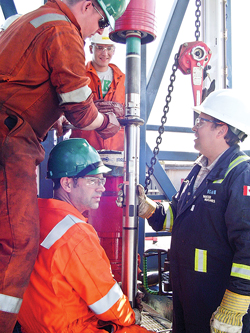 |
|
Real-time downhole communication system
Baker Hughes received an award for its TeleCoil downhole communication system, which offers real-time downhole information and maximizes the efficiency of coiled tubing (CT) interventions by assuring depth accuracy while optimizing the operational effectiveness of downhole processes. System flexibility also enables CT-conveyed, real-time electric logging and perforating applications. By integrating intervention and logging operations, equipment and personnel are minimized on location. The system—which uses standard end fittings and attaches to the BHA with mechanical and electrical quick connectors—requires only minutes to hook up in the field. At surface, the conductor connects to a data acquisition system that processes and charts the downhole information.
|
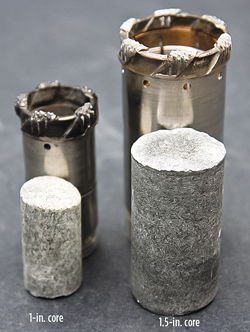 |
|
Large-diameter rotary sidewall coring service
Baker Hughes also received an award for its first-to-market MaxCOR rotary sidewall coring service. It acquires sidewall cores that are 225% more volume per unit length, enhancing accuracy of reservoir rock and fluid analysis. The system allows for the reliable retrieval of 60 cores during a single trip in a variety of operating conditions. Its coring efficiency is consistent, even in hostile environments up to 400°F and up to 25,000 psi. In unconventional reservoirs, such as shale plays, the technology’s high-quality shale core samples enable a more accurate characterization of complex shale reservoirs with routine and special core analysis.
|
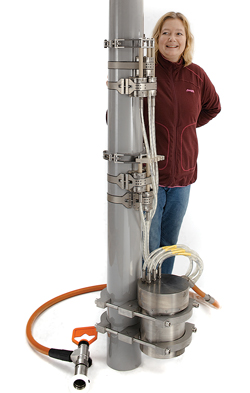 |
|
Real-time subsea corrosion-erosion monitor
ClampOn received an award for its Subsea Corrosion-Erosion Monitor (CEM). In real time, the technology continually monitors and quantifies changes of wall thickness over a large area of a pipeline and other metal structures. The CEM provides operators with an early warning of potentially catastrophic failures before they occur and is an effective tool in helping operators comply with newer regulations regarding the need for condition monitoring. The monitor can be retrofitted to existing structures or pre-installed on the outside of a pipe to provide pipe wear rates over entire sections up to 2 m in length.
|
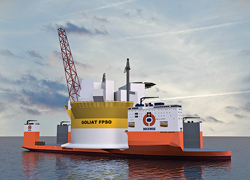 |
|
Semisub for dry-transport and offshore dry-docking
Dockwise received an award for its new Vanguard Type-0 vessel, which is the largest semi-submersible vessel ever built. At 902 ft long and 230 ft wide, the vessel can carry 110,000 tons and travel across oceans at 14 knots. Virtually all of the space on deck is clear and available for cargo.
The vessel has been designed for both the dry-transport and offshore dry-docking market. The Vanguard will have 50% greater lifting capacity and 70% greater deck area than the largest heavy lift ship now active, the Blue Marlin (owned by Dockwise).
Delivery is planned by fourth-quarter 2012. Upon delivery of the vessel by Hyundai Heavy Industries, it will transport the Jack/St. Malo platform hull from Korea to the U.S. Gulf of Mexico. After transporting the platform hull, the vessel will return to Korea to load and transport the Goliat floating, production, storage and offloading vessel (FPSO) to northern Norway.
|
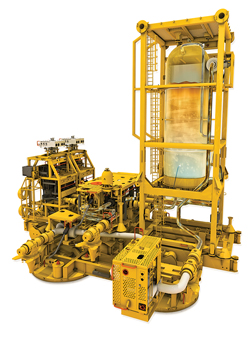 |
|
Subsea separation, boosting to produce multiple grades of hydrocarbons
FMC Technologies received an award for its Pazflor subsea separation system. The Pazflor development, located offshore Angola, is the first full-scale green field development with subsea separation and boosting to produce two different grades of hydrocarbons from four independent reservoirs. The system enables economic development of a reservoir that could not have been developed utilizing conventional subsea production system.
|
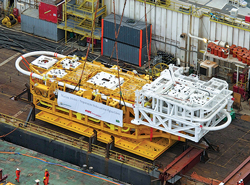 |
|
Oil-water subsea separation system boosts production in mature fields
Petrobras and FMC Technologies received an award for the Marlim Subsea Oil-Water Separation System (SSAO), which is the world’s first system for deepwater subsea separation of heavy oil and water that includes reinjection of water to boost production in a mature field development.
Developed for the Marlim field, offshore Brazil in the Campos basin, the SSAO debottlenecks the floating production facility and increases production by removing unwanted water from the production stream at the seabed. The module will separate heavy oil, gas, sand and water at a water depth of 2,950 ft.
The system applies FMC’s separation and sand management technologies, utilizing a novel pipe separator design, licensed and developed in cooperation with StatoilHydro. The separation system also includes cyclone modules that will perform water treatment before re-injecting the water back into the reservoir.
|
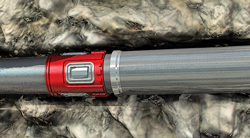 |
|
Autonomous inflow control device reduces water/gas production
Halliburton received an award for its EquiFlow autonomous inflow control device (AICD). The device, which contains no moving parts, improves completion reliability and efficiency by smoothing production throughout the interval, delaying water and gas breakthrough. This process greatly reduces water and gas production after breakthrough, and increases ultimate recovery from the well.
The technology is typically installed and combined with a sand screen in an unconsolidated reservoir. The reservoir fluid runs from the formation through the sand screen and into the flow chamber, where it continues through one or more tubes. Tube lengths and IDs (inner diameter) are designed to induce the appropriate pressure drop to move the flow through the pipe at a steady pace. Pressure drop is equalized, yielding a more efficient completion and adding to the producing life as a result of delayed water/gas coning.
|
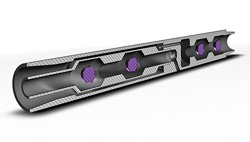 |
|
Downhole isolation system enables unlimited open/close operations
Reelwell received an award for its Downhole Isolation System (RDIS), which provides double barrier elements for use in a dual drillstring (DDS) arrangement. The RDIS enables an unlimited number of open/close operations, providing downhole isolation of the well whenever required. The technology provides a unique solution for improving safety and reliablity during DDS drilling operations.
|
 |
|
High-quality pressure measurements for all reservoir testing environments
Schlumberger received an award for its high-resolution, ultra-HPHT Signature quartz gauges. The devices provide precise, reliable pressure measurements in the most extreme environments. Utilizing ceramic multichip components bonded onto a single substrate, the gauges can withstand pressures up to 30,000 psi at temperatures of 410°F, all the while delivering high-resolution pressure measurements at recording rates as fast as 0.1 sec. Flexible data acquisition rates, greater memory capacity, and low power consumption allow personnel to run detailed tests longer, to reveal the finer features of a reservoir. The gauges allow for exploration beyond the near-wellbore area to obtain valuable information about permeability thickness, skin, boundaries and volumes.
|
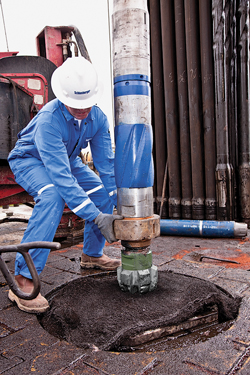 |
|
Rotary steerable system delivers high build rates
Schlumberger also received an award for its PowerDrive Archer high-build-rate rotary steerable (RSS) system, which delivers well profiles previously possible only with motors, yet with the ROP and wellbore quality of a fully rotating RSS. It has repeatedly and consistently delivered high build rates, at times over 17°/100 ft, which can maximize reservoir exposure, reduce risk and increase potential hydrocarbon production. The system can drill complex 3D wells from shoe-to-shoe and openhole sidetrack at any point. All external parts rotate, which reduces the risk of mechanical or differential sticking, and improves wellbore quality for easier well completion.
|
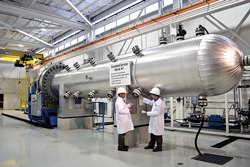 |
|
Simulated service vessel mimics deepwater environments
ShawCor received an award for its Simulated Service Vessel (SSV), which is the industry’s largest, most advanced deepwater test chamber for end-to-end thermal insulation systems. It is capable of simulating water depths to 3,000 m and temperatures up to 180°C. With real-time data acquisition, the SSV validates the long-term integrity of any subsea insulation system. The vessel is capable of simulating service conditions experienced by subsea insulation coatings by controlling the water temperature and applying pressure to the water surrounding the insulation coatings while controlling the temperature inside the pipe. By simulating these service conditions within the test vessel, and measuring the heat flow and compressive creep of the insulating material, companies are able to advise the pipeline design engineer of both the thermal efficiency and depth rating of the insulation.
|
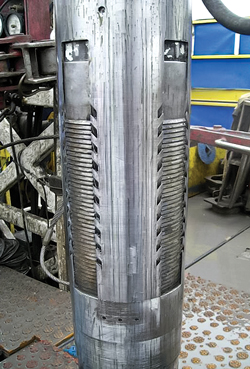 |
|
Liner drilling system with retrievable BHA
Tesco received an award for its patented Liner Drilling System. The technology enables operators to simultaneously drill a directional wellbore and run the liner in a single trip while always having the option to set the liner in tension anywhere in the parent casing. It also has the ability to retrieve the BHA without having to pull the liner the surface. The system includes an outer string made up of a liner and a profile nipple. An inner string, including a running tool, drill pipe and a drill lock tool, is lowered into the outer string and rotationally and axially locked to the outer string. Drilling may be performed by rotating the inner string, which also rotates the outer string. The operator may retrieve the inner string by pulling it and the liner upward until the upper end of the liner is located at the drilling rig floor. While supporting the liner at the drilling rig floor, the operator retrieves the inner string, then re-runs it back into the outer string.
|
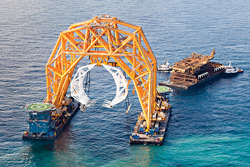 |
|
Underwater lift device retrieves topsides with minimal subsea preparation
Versabar received an award for its Claw underwater grappling device, which is used in conjunction with the company’s VB 10,000 Heavy Lift System. The device was developed in response to operator requests to minimize diver exposure during salvage and decommissioning operations. The Claw was designed to retrieve topsides from the sea floor with minimal subsea preparation. The two identical grappling devices measure 122 ft tall and 112 ft wide, and weigh 1,000 tons a piece. Custom-engineered baskets, or “cradles,” were built to use in conjunction with the lift. The cradles are lowered to the sea floor adjacent to sunken platforms, where they serve as a base upon which the fragile topsides can be lifted to the surface. Once the life device scoops up the damaged topside and deposits it on the cradle, the entire lift package is brought to the surface, placing no further stress on the topside.
|
|




















